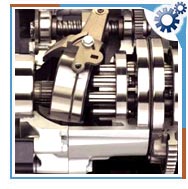 History
History Automatic transmission was based on technology first developed in the early 1900s by German manufacturers of marine engines. In 1938, General Motors developed the first line of cars with automatic transmission. The cars were introduced to the public in 1940 and by 1948, automatic transmission was a fairly common option on most American cars.
Introduction
Automatic transmission is the most complicated component in today's automobile. Automatic transmissions contain mechanical systems, hydraulic systems, electrical systems and computer controls, all working together in perfect harmony. There is no clutch pedal and gearshift in an automatic transmission.
Automatic transmission fluid
is specially formulated oil containing numerous additives to withstand grueling operating conditions. It serves multiple functions. It cleans cools, lubricates, transmits force, transmits pressure, inhibits varnish build-up and protects transmission.
A transmission is a device that is connected to the back of the engine and sends the power from the engine to the drive wheels.
Automatic Transmission Components
Planetary Gear Set - Mechanical systems that provide the various forward gear ratios as well as reverse.
Hydraulic System - Uses a special transmission fluid sent under pressure.
Seals and Gaskets - Used to keep the oil where it is supposed to be and prevent it from leaking.
Torque Converter - Acts like a clutch to allow vehicle to come to stop in gear while the engine is still running.
Governor and Modulator - Monitor speed and throttle position in order to determine when to shift.
Computer - Directs electrical solenoids to shift oil flow to the appropriate component at the right instant.
Types
There are two basic types of automatic transmission; the front wheel drive version called a transaxle and a rear wheel drive version called a transmission. Transaxle - it is a fully automatic electronically controlled front wheel drive transaxle with four forward gear ranges including overdrive and one reverse gear range. Power is transmitted to the drive wheels from the planetary gear through a final drive gear set and differential assembly. Transmission - normal automatic transmission is fully automatic with four forward and one reverse speed. It consists of a lockup torque converter assembly and a three unit planetary gear train.
Maintenance and Care
|
There are several ways to test an automatic transmission:
Air Pressure Test - To test the bands and servos inside the transmission, air pressure can be substituted for fluid pressure.
Line Pressure Test - Transmissions need to be operated with the proper fluid pressure.
Shift Point Road Test - Each shift in the transmission is supposed to occur at a specific time under certain throttle conditions.